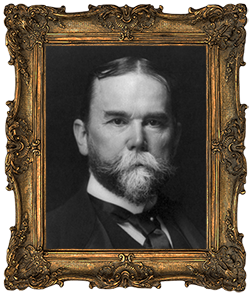The Teachers’ Tragedy on South Main Street - 1901
By: Jeremy Elliott, Washington County Historian - 2019
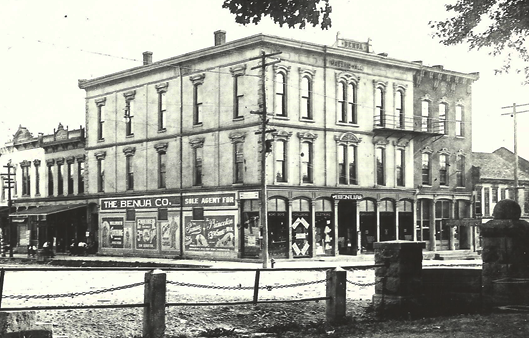
On a brisk, but otherwise pleasant Saturday, in November of 1901, three vibrant, young, female teachers, (from the Salem Grade School on Hay's Ave.), met up for an afternoon outing on the town. Miss Nellie Bare (28), Miss Nellie Gates (22) and Miss Bradie Shrum (21) had tickets for the 2:00pm matinee performance of the Eldon Comedy Troupe, who were performing in the old Knights of Pythias Armory/Opera House. Most recently, that building was occupied by Mr. T’s Antiques (Lot #1 Public Square) and the old opera house was located on the third floor, in what was then known as the Benua Building (shown in the picture above).
The Eldon Comedians were a highly touted, Midwest traveling, comedy/variety show, in the spirit of vaudeville, that operated from the 1890s until around 1915. One Indiana newspaper of the time, wrote the following about an upcoming performance;
“Eldon’s Comedians come highly recommended by the press as one of the strongest comedy companies on the road today. Their plays are new, full of comedy, singing and dancing specialties. The company is composed of 18 actors, headed by G.H. Eldon, the clever young comedian, who stands in the front rank of the fun makers of the day. He is ably assisted by Miss Bessie Clifton, the charming, singing and dancing soubrette.
As the house will undoubtedly be packed, it is advisable to get reserve seats early.”
Just before the play concluded, around 4pm, the three young ladies decided to exit the hall early. Their reasons were not recorded, but they were observed by several people along the street to be chatting, smiling, laughing, and cheerful, all the way around. Exiting through the side door, on the east side of the building, the women turned north and proceeded towards the square. They turned west at the front of the Benua Building and strolled down the sidewalk, enjoying one another’s company. The two younger ladies escorted Nellie Bare to the first building on the west side of the square, which was the residence of her parents, Dr. and Mrs. John Bare, and also where her father maintained his doctor’s office (the building still stands today, and is the new home of Nana’s This & That). This block of the square has been known historically, as the Kimball Block; just as the block north is known as the Lyon Block. The Kimball Block was named for a successful merchant, Nathaniel Kimball, who owned and constructed the first hand-hewn log buildings which occupied that section of our town square, shortly after it was laid out in 1814. Nathaniel was killed in a tragic flatboat accident, on the Ohio River in 1828, while transporting goods to the port of New Orleans.
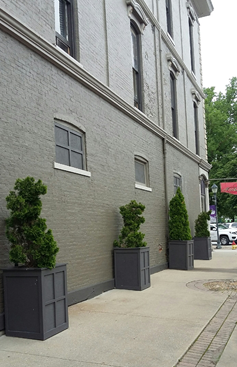 Site of the Tragic Accident todayAfter seeing Miss Bare home, Nellie Gates and Bradie Shrum retraced their steps back down South Main Street, to the Routh’s Furniture store, where Nellie had dropped off a picture to have it framed. (Routh’s Furniture Store, at that time, occupied all 3 buildings on South Main Street, from the Benua Building to the corner of Poplar St.)
Site of the Tragic Accident todayAfter seeing Miss Bare home, Nellie Gates and Bradie Shrum retraced their steps back down South Main Street, to the Routh’s Furniture store, where Nellie had dropped off a picture to have it framed. (Routh’s Furniture Store, at that time, occupied all 3 buildings on South Main Street, from the Benua Building to the corner of Poplar St.)
Completing the purchase in a matter of minutes, the duo exited the store and turned north towards the public square again. Once more passing by the east side of the Benua Building, the two women were admiring the newly acquired picture and each had a hold of opposite sides of the frame. Nellie commended the picture, saying, “Isn’t it cunning”.
At this same moment (4:20pm), on the same sidewalk, three employees of the K of P Opera House were laboriously working towards hoisting a 200-220 pound barrel of coal up to the third floor window, using an old pulley system. Glen Wright was on the third floor, pulling the rope attached to the barrel of coal and Elbert Fultz was standing at the open window, waiting to catch the barrel and pull it inside. Outside, on the sidewalk, holding the guide wire was David Butterfield.
According to the Salem newspaper of the day, this had been the common practice for getting large objects up to the third floor, since the buildings construction in the early 1880s. Through the years, pianos, costume trunks, stage scenery, coal for the two stoves on the floor, and a variety of other things had been lifted from the sidewalk to the 3rd floor, using the pulley, without incident.
However, on this day, just as the barrel was about to reach its apex, and Mr. Fultz was leaning out from the window to grab ahold of it, a knot in the rope passed through an iron eyelet, and either pulled loose, or snapped the rope bearing the cargo. Realizing what had happened, Mr. Butterfield, standing on the walk, holding the guide wire, cried out; “Look out ladies!”
Unaware of the men’s activities and completely unconscious of any danger, the two women instantly stopped in their tracks, standing directly under the open window on the third floor, (This would be the fourth window from the face/north-side of the building, or the second window the women passed under after leaving Routh’s Furniture Store). Miss Gates was standing on the inside, nearer the building, and Miss Shrum on the outside.
Another passerby at this moment, along the sidewalk, was a young scholar of Miss Shrum’s at the Salem Grade School; 13 year old, Merrill Jackson. Merrill shrewdly reached out and grabbed Bradie by the arm, pulling her down into the rip rap ditch, spraining her ankle, but undoubtedly saving her life. She would also receive cuts and scratches from the flying debris.
Poor Miss Nellie Gates wasn’t so fortunate. Nellie had come to Salem, just two years prior to start her teaching career. She was born and raised in Carthage, Indiana, a small town of around a 1,000 people in Rush County. She was placed in charge of the 6th Grade classes, and was made the Art Teacher at the Salem Grade School, on Hays Avenue. When she arrived in 1899, she began her career in the old Salem Grade School, that was constructed in 1872, but burned down just months after Nellie had started. The following school year, (1900-01), she was fortunate to teach in the newly constructed grade school, where she was teaching at the time of the accident. Since arriving, her reputation had steadily grown with her pupils, co-workers, and school officials, as well as in the community. She was a model young citizen and boarded with a Civil War Veteran and his wife, Edward and Lucinda (Uppinghouse) Conner, on North Water Street. She had further ingratiated herself by enthusiastically accepting the role of Sunday school teacher for the Salem Methodist Church. And just the previous summer, Nellie had enrolled and completed classes at the Indiana State Normal School, (now Indiana State University), and had intentions of returning to further her knowledge of her chosen profession.
Oblivious of her potential or her future aspirations, a terrible misfortune fell from the sky that day, crushing young Nellie Gates, and her life, into the cement sidewalk. The barrel struck her in the head, causing immediate severe lacerations and skull fractures, before collecting her underneath it, for the final few feet of its trajectory to the walk; where the barrel exploded over poor Nellie, throwing splinters, shards of wood, and chunks of coal in all directions.
Bystander, William Beal had witnessed the terrible scene of her being crushed under the weight of the barrel and was first to rush to her aid. He lifted and held her fading and damaged body in his arms until Doctor Havilla C. Hobbs and Doctor John Bare arrived within a few minutes. By then, hundreds of onlookers had flocked to the spectacle and all were willing to offer any assistance they could render for the young victim. Several assisted in transferring Nellie, from the sidewalk to a cot, and into Routh’s Furniture Store.
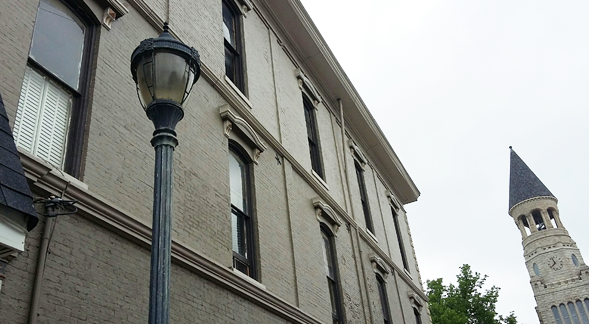
Someone had ran to North Water Street, to inform the Connor home, where Nellie had boarded the past two years. Mrs. Lucinda Conner rushed to the side of her young tenant and lovingly remained there throughout her entire affair.
 Very early photo of the Salem Grade School faculty; (circa1900-10). Miss Bradie Shrum is 3rd from left, in the second row. Miss Gates may be in this photo, but I have been unable to positively identify anyone outside of Miss Shrum.
Very early photo of the Salem Grade School faculty; (circa1900-10). Miss Bradie Shrum is 3rd from left, in the second row. Miss Gates may be in this photo, but I have been unable to positively identify anyone outside of Miss Shrum.
Once inside, the two doctors made a thorough examination of the patient and conferred with one another, electing to perform an immediate surgery, but were looking for a more suitable location to perform the procedure. Two more local doctors, Dr. James B. Wilson and Dr. William C. Cauble, rushed into the furniture store to offer their assistance with the patient.
Still unconscious, Nellie was then removed to the main parlor of Salem’s most noted hotel, the Hungate House, (which stood where the Brick Street Sampler store is today, but the old building was torn down in 1929). Here all four doctors collaborated to perform the operation.
According to my medical sources, this emergency surgery was likely to drill a burr hole (also known as trepanning) in Nellie’s cranium, to enable the release of pressure from hemorrhage, or epidural hematoma. Delay in releasing this compression will rapidly result in brain damage or death. Additionally, the doctors were able to remove dangerous bone fragments, resulting from her crushed skull.
Nellie endured the operation without any further complications. After the procedure, the doctors quelled her blood loss, cleaned her wounds and did everything they possibly could to relieve the patient from any suffering. Sadly, about 10 minutes later, her final relief was granted and she expired at 6:00pm. Her body was then taken to the Connor home, on North Water Street, for preparations for her expected journey back to Carthage.
According to the Salem newspaper, “The entire town was simply appalled at the awful accident. A more quiet Saturday night in the town could not be recalled. Salem has not been so shocked in years and it will require a long time for the people to recover from the sad scenes surrounding the death of Miss Gates.”
The evening performance of Eldon’s Comedians, at the K of P Opera House, was cancelled. Likewise, business in the town, of virtually every kind, was suspended for Saturday night.
Mr. Lewis Dennis, the manager of the Knights of Pythias Opera House, was deeply affected by the tragedy and probably held as much regret as anyone. He voluntarily offered to pay for all expenses related to the incident, including Nellie’s burial.
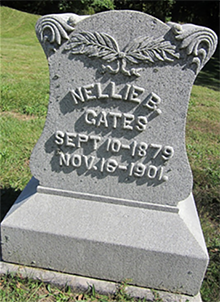 Nellie’s parents, in Carthage, were notified immediately, however, her mother, Adda, was an invalid and her father, Amos, was terribly ill at the time, so they were unable to make the 110 mile trip to Salem. They quickly dispatched a Carthage undertaker, Mr. Ray Johnson, to travel here to collect their daughter’s body.
Nellie’s parents, in Carthage, were notified immediately, however, her mother, Adda, was an invalid and her father, Amos, was terribly ill at the time, so they were unable to make the 110 mile trip to Salem. They quickly dispatched a Carthage undertaker, Mr. Ray Johnson, to travel here to collect their daughter’s body.
Throughout the evening, many of Miss Gates students, along with numerous other town citizens, came by the Ed & Lucinda Connor home, to pay their last respects and several volunteered to help sit through the night with her body.
Many in Salem, including the school system had wished to have a memorial service for Nellie, to show how respected she was in the community, but her parents desired to have her body returned immediately. So when Mr. Johnson, the Carthage undertaker, arrived on the train Sunday morning, a very abbreviated impromptu service was held at the Connor house on North Water Street, conducted by Reverend A.D. Batchelor, of the Salem Methodist Church. Afterwards, a throng of grieving friends, associates and students accompanied her remains to the Monon Station, on South Main Street, where hundreds of other sorrowful citizens had gathered to pay their final respects.
Accompanying the remains back to Carthage from Salem, were Superintendent of the Salem Schools, Professor Henry B. Wilson and Miss Bradie Shrum, who were said to be of great comfort to Miss Gate’s parents and remained in Carthage for the funeral services, on November 19, 1901. The public service there was likewise, heavily attended by a grieving community, and several tributes were made to the unfortunate victim, before she was transported and interred in the Riverside Cemetery, in Rush County.
This unfortunate story is one of many tragedies that have played out over the 205 year history of the Salem Public Square. It is dedicated to the current building owner and Washington County Historical Society Director, Richard Trueblood, who requested the story be retold, so the memory of Miss Nellie Gates is not forgotten.


